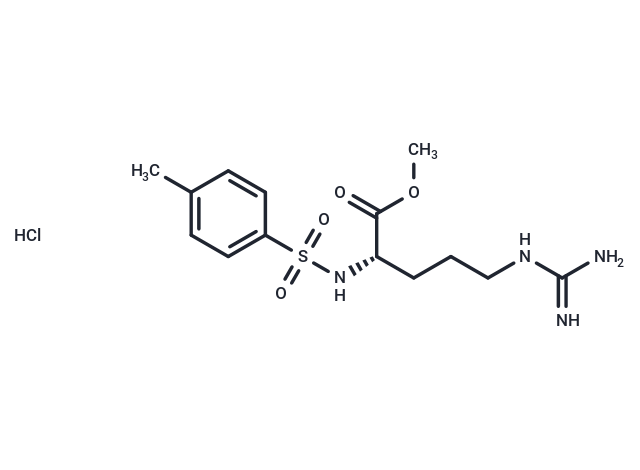Shopping Cart
- Remove All
 Your shopping cart is currently empty
Your shopping cart is currently empty

TAME hydrochloride (Tos-Arg-OMe HCl) is a kind od amino acid derivatives.

| Pack Size | Price | Availability | Quantity |
|---|---|---|---|
| 25 mg | $30 | In Stock | |
| 50 mg | $42 | In Stock | |
| 100 mg | $77 | In Stock | |
| 500 mg | $187 | In Stock | |
| 1 mL x 10 mM (in DMSO) | $46 | In Stock |
| Description | TAME hydrochloride (Tos-Arg-OMe HCl) is a kind od amino acid derivatives. |
| Kinase Assay | This clonal cell line, referred to as HEK 293 4.0-7 cells, are used in a high-throughput screening format to detect agonists and allosteric activators of the Ca2+?receptor. Changes in the concentration of cytoplasmic [Ca2+]i provide a quantitative and functional assessment of Ca2+ receptor activity in these cells and the results using this assay parallel those obtained using a homologous expression system of bovine parathyroid cells. On-line continuous measurements of fluorescence in fluo-3- or fura-2-loaded HEK 293 4.0-7 cells are obtained using a custom-built spectrofluorimeter or a fluorescence imaging plate reader instrument. NPS-2143 is incubated with cells for 1 minute before increasing the concentration of extracellular Ca2+?from 1.0 mM to 1.75 mM. NPS-2143 is tested individually at a concentration of 100 μg/mL (20 μM-80 μM) and those causing more than a 40% inhibition of the control response are considered to be biologically active. To determine the potencies (IC50) of NPS-2143 with biological activity, concentration-response curves are obtained and then, as an initial assessment of selectivity, the effects of NPS-2143 on [Ca2+]i evoked by other G protein-coupled receptors are examined at a concentration several times their IC50. Wild-type HEK 293 cells (and HEK 293 4.0-7 cells) express receptors for thrombin, bradykinin, and ATP, which couple to the mobilization of intracellular Ca2+. These responses can be studied to quickly assess any nonselective action of compounds on G protein-coupled receptors. Additional assays for selectivity include HEK 293 cells engineered to express receptors most homologous in sequence and topology to the Ca2+ receptor. These include native or chimeric receptors for various metabotropic glutamate and γ-aminobutyric acid type B receptors (GABABRs).Chimeric receptors are created using partial sequences of metabotropic glutamate receptors and Ca2+?receptors, engineered to couple to activation of phospholipase C and release of intracellular Ca2+?in HEK 293 cells. NPS-2143 lacking pan-activity are then subjected to structural modifications and their potencies and selectivities monitored using these HEK 293 4.0-7 cell assays in an iterative process. |
| Alias | TOS-ARG-OME hydrochloride, Tos-Arg-OMe HCl |
| Molecular Weight | 378.87 |
| Formula | C14H23ClN4O4S |
| Cas No. | 1784-03-8 |
| Smiles | Cl.COC(=O)[C@H](CCCNC(N)=N)NS(=O)(=O)c1ccc(C)cc1 |
| Relative Density. | no data available |
| Storage | Powder: -20°C for 3 years | In solvent: -80°C for 1 year | Shipping with blue ice. | |||||||||||||||||||||||||||||||||||
| Solubility Information | DMSO: 60 mg/mL (158.37 mM) | |||||||||||||||||||||||||||||||||||
Solution Preparation Table | ||||||||||||||||||||||||||||||||||||
DMSO
| ||||||||||||||||||||||||||||||||||||

Copyright © 2015-2024 TargetMol Chemicals Inc. All Rights Reserved.